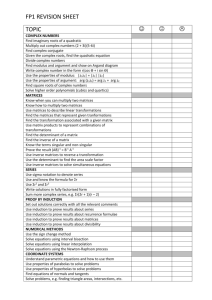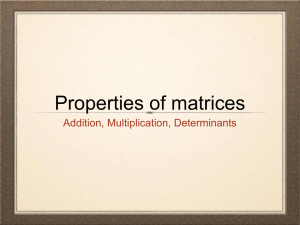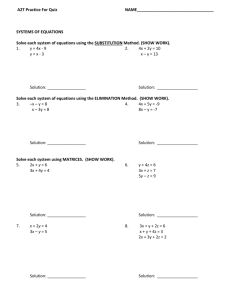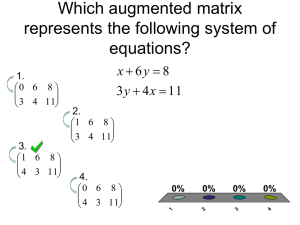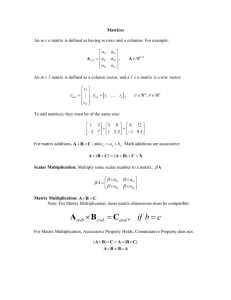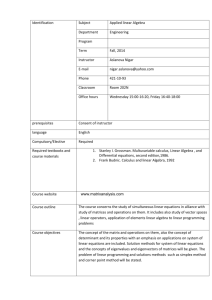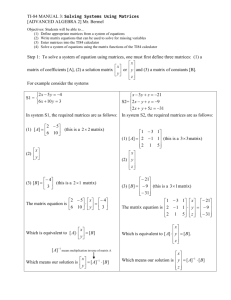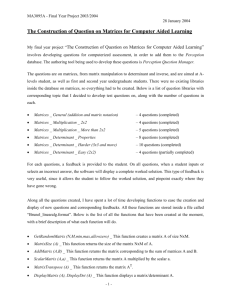Solution
advertisement
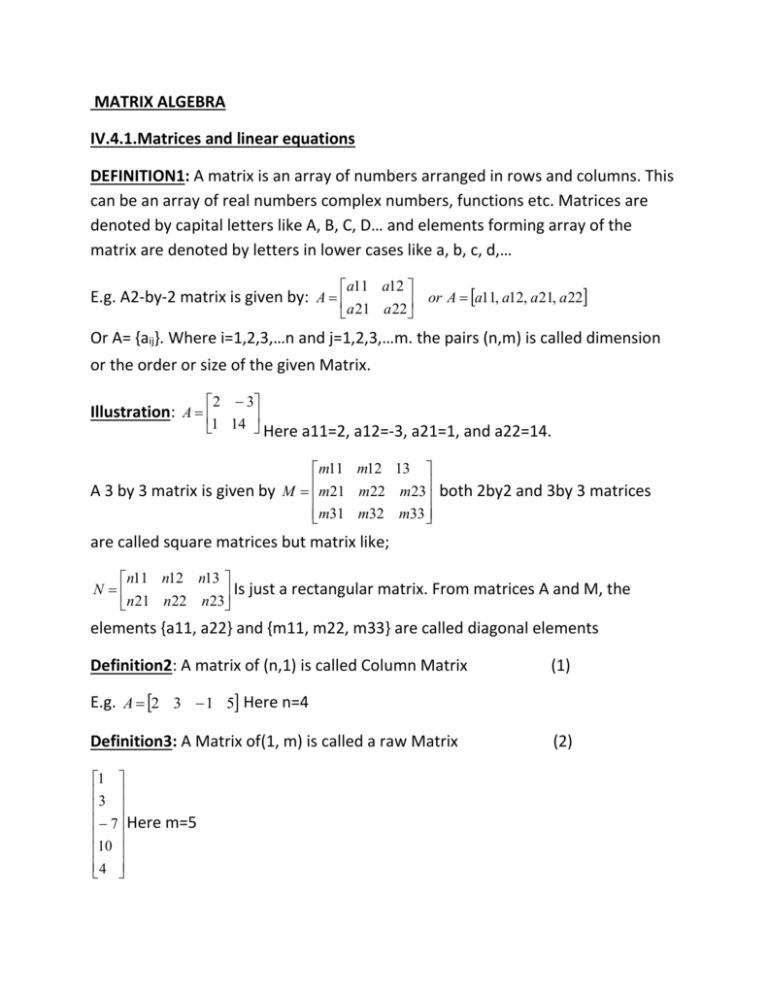
MATRIX ALGEBRA
IV.4.1.Matrices and linear equations
DEFINITION1: A matrix is an array of numbers arranged in rows and columns. This
can be an array of real numbers complex numbers, functions etc. Matrices are
denoted by capital letters like A, B, C, D… and elements forming array of the
matrix are denoted by letters in lower cases like a, b, c, d,…
a11 a12
E.g. A2-by-2 matrix is given by: A
or A a11, a12, a 21, a 22
a 21 a 22
Or A= {aij}. Where i=1,2,3,…n and j=1,2,3,…m. the pairs (n,m) is called dimension
or the order or size of the given Matrix.
2 3
Illustration: A
1 14 Here a11=2, a12=-3, a21=1, and a22=14.
m11 m12 13
A 3 by 3 matrix is given by M m21 m22 m23 both 2by2 and 3by 3 matrices
m31 m32 m33
are called square matrices but matrix like;
n11 n12 n13
N
Is just a rectangular matrix. From matrices A and M, the
n21 n22 n23
elements {a11, a22} and {m11, m22, m33} are called diagonal elements
Definition2: A matrix of (n,1) is called Column Matrix
(1)
E.g. A 2 3 1 5 Here n=4
Definition3: A Matrix of(1, m) is called a raw Matrix
1
3
7 Here m=5
10
4
(2)
Note: A set of Matrices whose dimension is (n, m) is denoted as Mn,m( )
Definition: Diagonal Matrices are Matrices whose diagonal elements are not zero
and others are all zero.
1 0 0
E.g. A= 0 3 0 A is diagonal Matrix.
0 0 2
Definition5: Identity Matrix is a Matrix whose diagonal elements are 1 and others
are all zero.
1 0 0
E.g. M= 0 1 0 M is identity Matrix.
0 0 1
Definition6.A scalar Matrices are Matrices obtained by multiplying identity matrix
by any non-zero number (α).
1 0 0
let M 0 1 0
0 0 1
and Let 3 B 3M
or
3 0 0
B 0 3 0 Matrix B is scalar Matrix
0 0 3
Definition6: A Matrix is said to be symmetric if and only if AT=A
1 2 3
1 2 3
T
E.g. Let A= 2 4 9 and A = 2 4 9 Therefore A is symmetric Matrix.
3 9 0
3 9 0
Definition7: Triangular Matrices are those Matrices whose elements above or
below the diagonal elements are all zeros.
1 2 3
1 0 0
Examples: 0 4 9 or 2 4 0 these are triangular Matrices.
0 0 2
3 9 2
Definition8: Orthogonal Matrix A is the square Matrixsuch that ATA= (AA)T
=Identity Matrix of the same size of A.
1
9
4
E.g. Let A=
9
8
9
8
9
4
9
1
9
4
9
7
9
4
9
Note that if a Matrix A is orthogonal, then it is invertible Matrix with the following
property that A-1=AT
IV.4.2.Vectors and matrices and their Algebra
a. Vectors:
Definition: A real linear vector space (resp. complex linear vector space is a set
V, equipped with 2 binary operations: the addition (+) and the scalar
multiplication (r) Such that:
x+y = y+x, ∀x, y ∈ V
x+(y+z) = (x+y)+z, ∀x, y, z ∈ V
There is an element 0V in V such that x+0V = 0V +x = x, ∀x ∈ V
For each x ∈V, there exists an element −x ∈V such that x+(−x) = (−x)+x = 0V
For all scalars r1, r2 ∈R (resp. c1, c2 ∈C), and each x ∈V, we have
r1.(r2.x)=(r1r2).x (resp. c1.(c2.x) = (c1c2).x
6. For each r ∈ R (resp. c ∈ C), and each x1, x2 ∈ V, r.(x1 +x2) = r.x1 +r.x2
(resp. c.(x1+x2) = c.x1+c.x2)
7. For all scalars r1, r2 ∈ R (resp. c1, c2 ∈ C), and each x ∈ V, we have (r1 +r2).x
= r1.x+r2.x (resp. (c1+c2).x = c1.x+c2.x)
8. For each x ∈ V, we have 1.x = x where 1 is the unity in R (resp. in C).
1.
2.
3.
4.
5.
Example: The following are linear vector spaces with the associated scalar fields:
n with R, C n with C.
Definition:
A subset M of a vector space V is a subspace if it is a linear vector space in its own
right. One necessary condition for M to be a subspace is that it contains the zero
vectors.
Let x1, x2, x, . . .xn be some vectors in a linear space X defined over a field F. In
these notes we shall consider either the real field R or the complex field C. The
Span of the vectors x1, x2, x3 . . .xn over the field F is defined as
n
SpanF{x1, x2, x3, . . .xn} := {x ∈X : x = aiXi , ai∈ F}.The vectors x1, . . .xn are said
n 1
to be linearly independent if:
n
aiXi
=0 ⇒ai = 0, i =1. . .n otherwise they are linearly dependent. A set of
vectors x1, . . .xm is a basis of alinear space X if the vectors are linearly
independent and their Span is equal toX . In this case the linear space X is said to
have finite dimension m.Note that any set of vectors containing the zero vector is
linearly dependent. Also, if {xi} i = 1, ···,n is linearly dependent, adding a new
vector xn+1 will notmake the new set linearly independent. Finally, if the set {xi} is
linearly dependent, then, at least one of the vectors in the set may be written as a
linear combination ofthe others. How do we test for linear
dependence/independence? Given a set of n vectors{xi} each having m
components. Form the m×nmatrixA which has the vectorsxi as its columns. Note
that if n > m then the set of vectors has to be linearlyindependent. Therefore, let
us consider the case where n ≤ m. Form the n×nmatrix G = ATA and check if it is
nonsingular, i.e. if | G |≠0, then {xi} is linearly independent, otherwise {xi} is
linearly dependent.
n 1
IV.4.3.Systems of linear equations and their expressions in matrix form
In many control problems, we have to deal with a set of simultaneous linear
algebraic equations
a11x1+a12x2+···+a1nxn = y1
a21x1+a22x2+···+a2nxn = y2
am1x1+am2x2+···+amnxn = ym. Or in matrix notation
a11 a12 a13...a1n
a 21 a 22 a 23...a 2n
for an m×n matrix A, an n×1 vector x and
Ax = y where A=
................................
an1 an 2....an3......anm
an m vector y. The problem is to find the solution vector x, given A and y. Three
cases might take place:
1. No solution exist
2. A unique solution exists
3. An infinite number of solutions exist
Throughout this chapter, we shall only deal with the second case where, there is a
unique solution of a system.Now, looking back at the linear equation Ax = y, it is
obvious that y should be in (A) for a solution x to exist, in other words, if we
form W = [A | y]then rank(W) = rank(A) is a necessary condition for the existence
of at least one solution. Now, if z ∈ N (A), and if x is any solution to Ax = y, then
x+z is also a solution. Therefore, for a unique solution to exist, we need that N (A)
= 0. That will require that the columns of A form a basis of (A), i.e. that there
will be n ofthem and that they will be linearly independent, and of dimension n.
Then, the A matrix is invertible and x = A−1y is the unique solution.
Illustration:
Let the system of equations be:
2x1+4x2-x3=4
X2+3x2+7x3=2
3x1+5x2+x3=-1
Write the above equations in matrix form.
Solution:
2 4 1 x1 4
2 4 1
x1
1 3 7 x x 2 = 2 Here matrix A= 1 3 7 Vector matrix X= x 2 and
3 5 1 x3 1
3 5 1
x3
4
Y= 2 Therefore the above expression can be written as AX=Y
1
IV4.4.Inverse matrices and some of its applications
1. Determinant of matrices
a. Determinant of 2-by-2Matrices
a11 a12
be any 2by2 Matrix, the determinant of matrix A written as
a 21 a 22
Let A=
A|is a scalar given by: a11a22-a12a21
2 1
Therefore the determinant of Matrix A is
3 5
E.g. A=
|A|=2x5-1x3
=10-3 or det. A=7 which is nothing other than the surface area of a
parallelogram having four sides formed by vectors V1(x1, x2) and V2(x1, x2).
|
b. Determinant of a 3-by-3 Matrices
a11 a12 a13
Let A= a 21 a 22 a 23
a31 a32 a33
be any 3by3 Matrix, the determinant of Matrix A |A| is
found by the following methods:
i.
Minorsand cofactors.
This can be found as follows: a11
a 22 a 23
a 21 a 23
a 21 a 22
a13
-a12
where the
a32 a33
a31 a33
a31 a32
terms in | | are the determinants of matrices of a 2-by-2. Here minors are got
by deleting ith row and jth column.We can obtain the cofactors given by:
Cij = (−1)i+jMij
2 4 1
Example: Given A= 3 0 2 Then M12=5, C12=-5, M32= C32=1.
2 0 3
2 4 3
E.g. find the determinant of matrix A by minors’ method, given that A= 1 2 1
0 1 1
|A|=2
2 1
1 1
1 2
4
3
or det. A= 2(2-1) +4(-1) +3(1) =1 and this is
1 1
0 1
0 1
nothing other than the volume of square figure.
Sarus’s method
a11 a12
a13
a11
a12
a21 a22 a23
a21
a22
a31 a32 a33
a31 a32
The determinant of A is now |A|= (a11a22a33+a12a23a31+a13a12a32)(a31a22a13+a32a23a11+a33a21a12) or one can extend elements of the matrix as follows;
a11
a12
a13
a21
a22
a23
a31
a32
a33
a11
a12
a13
a21
a22
a23
|A|= (a11a22a33+a21a32a13+a31a13a23)-(a21a12a33+a11a32a23+a31a22a13)
E.g. Use Sarus’s method to find the determinant of the matrix in e.g. above
Sol: 2
-4
3
2 -4
1
-2
1
1
-2
0
1
-1
0
1
|A|= (2x-2x-1+3x1x1)-(1x1x2+-1x1x-4)=1 or one can extend elements of the
matrix as follows;
2
-4
3
1
-2
1
0
1
-1
2
-4
3
1
-2
1
|A|= (2x-2z-1+1x1x3)-(1x-4x-1+2x1x1)=1 which is nothing other than the volume
a parallelepiped having three vectors V1(x1, x2, x3), V2(x1, x2, x3) and V3(x1, x2, x3)
Properties of the determinant
i.
When we interchange the raw or columns of a matrix A to obtain a
matrix B, then det.(A)= det.(B)
2 4 3
E.g. Let A= 1 2 1 and
0 1 1
2 3 4
1 2 1
B 1 1 2 and then C= 2 4 3 Here
0 1 1
0 1 1
|A|=|B|=|C|.
ii. If αϵ , A is a Matrix, if αmultiplies a raw or a column then det( A) det( A)
6 4 3
E.g. A 3 2 1 and
0 1 1
2 4 3
B 2 4 2
0 1 1
as A and B were found by multiplying
the first column by3 and the first row by 2 respectively and as |A|=1, A =3x1=3
and B 2x1=2. Consequently, if α multiplies all the elements of the matrix A,
then |Α|=αn|A| where n stands for the order or dimension of the matrix A
iii. det.(AXB)= det.(A) x det.(B)
6 4 3
2 4 3
E.g. If A 3 2 1 and B 2 4 2 as
0 1 1
0 1 1
A 3 and B 2 Then det( AXB) det( A) x det( B)
That is 3x2=6
ii.
Det.(A-1)=
1
where A-1 is the inverse
det( A)
2 1
det.(A)=8-3=5
3 4
E.g. Let A=
1
1
det( A) 5
|A-1|=
iii.
1
A
If B is obtained from A by adding a multiple of a raw or column of A,
then |A|=|B|
Note: We only find the determinant of square matrices.
Transpose of a Matrix:
a11 a12
written as AT is found by
a 21 a 22
The transpose of a Matrix A =
interchanging rows and columns as follows;
a11 a 21
a12 a 22
AT =
Illustration: Let A=
1 3
22 1
1 22
AT
3 1
Some properties of the transpose of a Matrix
If A is a square matrix, then |A|=|AT|
i.
2 4 3
2 1 0
T
E.g. A= 1 2 1 and A 4 2 1 Therefore
0 1 1
3 1 1
A AT
ii. (A+B)T=AT+BT
1 2
2 4
E.g. M
and N 0 1
3 1
Solution:
Det. (A x B)T=det.(B)T x det.(A)T. Consequently det.(A x B x C x…M x
N)T=det.(NT)det.(MT)x…det.(CT) x det.(BT)x det.(AT)
2. Inverse Matrix
a. The inverse of the matrix 2by2 is found by
ii.
a11 a12
-1
be any 2-by-2 matrix, the inverse of A written by A Is found by
a
21
a
22
Let A
A-1=
1 a 22 a 21
det( A) a12 a11
2 0
4 1
E.g.find the inverse of A=
Solution: det. (A)= 2-0=2
1
1 1 4
A =
2
2 0 2
0
-1
4
2
1
0.5 2
or
1
0
b. The inverse of a 3-by-3 matrix
a11 a12 a13
Let A= a 21 a 22 a 23 be any 3by3 Matrix, the inverse of 3by3 matrix is found by;
a31 a32 a33
T
m11 m12 m13
1
-1
m 21 m 22 m 23 where mij are the cofactors found by minors.
A =
det( A)
m31 m32 m33
Illustration:
Find the inverse of the following Matrix
2 4 3
A 1 2 1
0 1 1
Some application of inverse matrices
i.
In technology:
There are many ways to encrypt a message. And the use of coding has become
particularly significant in recent years (due to the explosion of the internet for
example). One way to encrypt or code a message uses matrices and their inverse.
Indeed, consider a fixed invertible matrix A. Convert the message into a matrix B
such that AB is possible to perform. Send the message generated by AB. At the
other end, they will need to know A-1 in order to decrypt or decode the message
sent. Indeed, we have
which is the original message. Keep in mind that whenever an undesired intruder
finds A, we must be able to change it. So we should have a mechanical way of
generating simple matrices A which are invertible and have simple inverse
matrices. Note that, in general, the inverse of a matrix involves fractions which
are not easy to send in an electronic form. The best is to have both A and its
inverse with integers as their entries. In fact, we can use our previous knowledge
to generate such class of matrices. Indeed, if A is a matrix such that its
determinant is
and all its entries are integers, then A-1 will have entries which
are integers. So how do we generate such class of matrices? One practical way is
to start with an upper triangular matrix with
on the diagonal and integerentries. Then we use the elementary row operations to change the matrix while
keeping the determinant unchanged. Do not multiply rows with non-integers
while doing elementary row operations. Let us illustrate this on an example.
Example
Consider the matrix
First we keep the first row and add it to the second as well as to the third rows.
We obtain
Next we keep the first row again, we add the second to the third, and finally add
the last one to the first multiplied by -2. We obtain
This is our matrix A. Easy calculations will give det.(A) = -1, which we knew since
the above elementary operations did not change the determinant from the
original triangular matrix which obviously has -1 as its determinant. We leave the
details of the calculations to the reader. The inverse of A is
Back to our original problem. Consider the message
To every letter we will associate a number. The easiest way to do that is to
associate 0 to a blank or space, 1 to A, 2 to B, etc... Another way is to associate 0
to a blank or space, 1 to A, -1 to B, 2 to C, -2 to D, etc... Let us use the second
choice. So our message is given by the string
Now we rearrange these numbers into a matrix B. For example, we have
Then we perform the product AB, where A is the matrix found above. We get
The encrypted message to be sent is
ii.
In solving systems of equations
In many control problems, we have to deal with a set of simultaneous linear
algebraicequations
a11x1+a12x2+···+a1nxn= y1
a21x1+a22x2+···+a2nxn= y2
am1x1+am2x2+···+amnxn= ymor in matrix notation
Ax = y for an m×nmatrix A, an n×1 vector x and an m vector y. The problem is to
findthe solution vector x, given A and y
Rank, Trace,Adjoint of Matrices and, Singular, Regular Matrices
1. Rank of a Matrix:
The rank of an m×nmatrix A denoted by rA= rank(A) is the size of the largest
Non-zero determinant that can be formed from A. Note that rA≤min{m,n}. If A
issquare and if rA= n, then A is non-singular. If rAis the rank of A and rBis the rankof
B, and if C = AB, then 0 ≤rC≤min{rA, rB}.
2. The trace of a Matrix.
n
The trace of a square matrix A can be defined as Tr. (A) =
i 1
=1 aii.
Illustration:
2 4 1
A= 3 0 2 It is easy to see that rA = 3. Now consider the matrix
2 0 3
2 0
17 1
B= 3 0 whose rank is rB = 2 and form A.B= 8 2 and the rank(C) = 2 ≤ {rA, rB}.
1 1
1 1
Note that If A and B are conformable square matrices, Tr. (A + B) = Tr. (A) +Tr. (B),
and Tr. (AB) = Tr. (BA). Also, Tr. (A) = Tr. (AT).If A and B are conformable square
matrices, Tr. (A + B) = Tr. (A)+ Tr. (B), and
Tr. (AB) = Tr. (BA). Also, Tr. (A) = Tr. (AT).
Example
Show that Tr. (ABC)=Tr. (BTATCT). First, write Tr. (ABC)=Tr. (CAB), thenTr.([CAB]T) =
Tr. (CAB), thus proven.Note that rank (A+B) ≠ rank (A)+rank(B) and that Tr. (AB) ≠
Tr. (A)×Tr. (B).
Example
1 0 0
2 4 1
A 3 0 2 And B= 0 0 0 and note that rA = 3, rB = 1, while rA+B= 3. Also, note
0 0 0
2 0 3
that Tr. (AB) = 2 while Tr. (A) ×Tr. (B) = 5×2 = 10.Next, we define the inverse of a
square, nonsingular matrix A as the square matrix B of the same dimensions such
that AB = BA = I.The inverse is denoted by A−1 and may be found by
A−1 =
CT
where C is the matrix of cofactors Cij of A. Note that for the inverse to
| A|
exist, | A | must be nonzero, which is equivalent to saying that A is nonsingular.
We also write CT = Ad joint (A).The following property holds:
(AB)−1 = B−1A−1assuming of course that A and B are compatible and both invertible.
Assuming of course that A and B are compatible and both invertible
3. Adjoint or com-Matrix of Matrix
a11 a12
We know that
a 21 a 22
Let A be any Matrix of size2 or a 2-by2 Matrix, A
det. (A) =a11a22-a12a21. The ad joint Matrix of A is given by:
a 22 a 21
or by the formula below:
a12 a11
Adj. (A) =
Ad joint (A)=Com(A)= Xij (1) i j ij where is the minor of aij Matrix.
2 5
3 7
E.g. Find the Adjoint of Matrix A, given that A=
7 3
5 2
Solution: Adj. (A) =
4. Singular or invertible and Regular Matrices
A singular or invertible Matrix is any square matrix whose determinant is not
zero, whereas a Regular Matrix is a matrix whose determinant is zero. This
means that a Matrix A is said to singular if there exist a square Matrix B such
that AB=BA =Identity Matrix. And Matrix B is unique.
IV.4.5.Application of simultaneous equations in business
a. The concept of supply and demand
This is a good example to use both to consolidate students’ understanding of
supply and demand but also to strengthen their mathematical understanding and
capacity to independently apply a technique to an economic problem.
b. Presenting the concept of supply and demand.
This guidance is intended to provide a logical and structured sequence of material
which covers supply and demand and the associated topics of equilibrium,
consumer and producer surplus, revenue and taxation.
i.
Supply and demand
A mathematical treatment of demand and supply is best motivated using a
straightforward example such as the one that follows. One of your activities is
handcrafting “silver” rings. Sometimes, you set up a stall and attempt to sell
them. You know from experience that: if you set a price of £1 per ring, you sell
eight rings; if you set a price of £2, you sell seven; if you set a price of £3, you
sell six;
•if you set a price of £4, you sell five;
:
:
•if you set a price of £9, you do not sell any!
Let P be the price that you set, and let Q be the number that you sell (Q
standing forQuantity). The information presented above is represented by the
following equation:
D: Q = 9 – P(1)
This equation is known as the demand equation for your silver rings. It shows
how many will be sold (Q) when the price is P.What price will you choose to
set? Well, actually, you don’t choose the price; you let the market choose it for
you. In order to find what price will emerge, we need to consider the supply
equation as well.If you are offered only £1 per ring, you are not willing to
spend time producing them, so you do not produce any. If you are offered £2,
you are willing to produce only one. If you are offered £3, you are willing to
produce two; and so on. If you are offered £10, you produce nine.So, if we
again let P be the price, but this time Q is the number you produce, the
equation implied by the information just given is:
S: Q = -1+ P
(2)
This equation is known as the supply equation for your silver rings. It shows how
many you are willing to produce (Q) when the price is P.
So, how many are sold, and at what price? We need to find the price at which the
number demanded equals the number supplied.
9-P=-1+P. Therefore P*=5
Notice this is the only price at which the number of rings that customers wish to
purchase is equal to the number of rings that you are willing to produce. For this
reason, it is called the equilibrium price. It is the price which will prevail if the
market is allowed to function freely.
We denote the equilibrium price as P*. How many rings are traded in equilibrium?
We can answer this by substituting the equilibrium price P* = 5 back into the
demand equation (or the supply equation):Q*=9-5=4. So, in equilibrium, 4 rings
are traded, at a price of £5 each.
(b) Linking to Supply and Demand Curves, Surplus and Revenue
The preceding material can easily be extended to cover these topics.
Students will need to be reminded of graphing conventions such that we show
quantity (Q) on the horizontal axis, and price (P) on the vertical but that in order
to do this; we first need to invert the two equations specified above.
That is:
Demand:
Q=9-P
(1)
P=9-Q
Supply:
Q=-1+P
(2)
P=-1+Q
And then to create the traditional supply and demand diagram:
(c) Linking to total revenue
Having computed the equilibrium price and quantity, it is a simple matter to
deduce the revenue earned by the producer or producers. This is simply the
product of price and quantity. So, in the example above, total revenue is:
Total Revenue = P*´Q* = 5´ 4 = 20;with total revenue represented by an area on
the graph by the area of the rectangle with two sides the axes and the other two
sides drawn parallel to the axes and passing through the equilibrium point.
(d) Linking to consumer surplus and producer surplus
(i) Consumer SurplusThe above figure can again be reproduced to remind
students of the original example where there was one customer who was
prepared to pay £8 for a ring and that this customer only pays the equilibrium
price of £5 and so therefore we say that this customer extracts consumer surplus
of £3. Likewise, there was another customer who was prepared to pay £7, but
only pays £5, thus extracting consumer surplus of £2. The customer who was
prepared to pay £6 extracts consumer surplus of £1. The customer, who was
prepared to pay £5, paysexactly this price, and extracts no consumer surplus. The
remaining customers are not prepared to pay the equilibrium price, and therefore
go without the product. This can be summarized as: consumer surplus being
conventionally computed as the area of the triangle enclosed by the demand
curve, the vertical axis, and the horizontal line at P*.To find this area, students
can use the triangle area which is half of a square with sides 4. Its area is
therefore:
1
x 4 x 4 8 Our measure of consumer surplus is therefore 8.
2
(ii) Producer Surplus
Next, students could focus on the supply curve by again reconsidering that the
first ring produced was prepared to sell for £2, but the supplier actually received
£5 and that therefore producer surplus of £3 was extracted from the sale of this
first ring. The second ring was prepared to sell for £3, with £2 of producer surplus
extracted, and so on. Students will need to know that the conventional measure
of total producer surplus is the area of the triangle enclosed by the supply curve,
the vertical axis, and a horizontal line at P*. This area is:
1
x4 x4 8
2
And the measure of producer surplus is 8.
(e) Linking to taxation
At the end of an introductory microeconomics module, many studentswill know
that the imposition of a tax on a good is represented by a parallel upward shift in
the supply curve by the amount of the tax. However, there is no doubt that
students find it hard to understand why a tax causes such a shift.
An explanation is provided here; Look at the supply curve used previously (in the
rings example). Imagine again that you are the producer. If you only produce one
ring, the minimum price you are prepared to accept for it is £2. Now imagine that
the Government imposes a tax of £2 per ring that you, the supplier, are required
to pay to the taxman when the purchase is complete. Then, the minimum price
you would be prepared to accept for the single ring is £4. Therefore the point on
the Supply curve corresponding to Q=1 has shifted upwards from P=2 to P=4.
If you produce two rings, the minimum price you are prepared to accept per ring
is £3. With the £2 tax imposed, the minimum you are prepared to accept
becomes £5. Hence the point on the supply curve corresponding to Q=2 also
shifts upwards by £2. In fact, the effect of the £2 tax per unit is an upward shift of
the entire supply curve by £2.
Generally, the effect of a tax is an upward shift in the supply curve by the amount
of the tax. The new supply curve is labeled as S’ in the figure below. Note that the
new equilibrium is shown as the point of intersection of the demand curve with
the new supply curve.
In order to solve for the equilibrium using algebra, we simply note that the
equation of the supply curve has changed from P =1+Q to P = 3+Q. The demand
curve is still P = 9 -Q. We therefore set 3+Q = 9 -Q which gives Q = 3. Substituting
into the demand equation then gives P = 9 - 3 = 6. Hence we have established that
the tax has moved the equilibrium from (4, 5) to (3, 6).
At this point, it needs to be stressed that the price increase (£1) is less than the
amount of the tax (£2). This is a consequence of the demand curve being
downward-sloping, and simply tells us that not all of the tax is passed on to the
consumer. The steeper the demand curve, the greater the price increase resulting
from the tax, and therefore the more of the tax that is passed on to the
consumer. The amount of tax raised by the government (government revenue) is
obtained by simply multiplying the after-tax quantity by the amount of the tax. In
the example, government revenue is 3 ´ 2 = 6.
IV.4.6.Solving systems of linear equations using row operations (in the case
where there is a unique solution).
Solving a system of equations follow the three possible operations:
i.
ii.
iii.
interchange two rows;
Multiply or divide a row by a non-zero constant factor;
Add to, or subtract from, one row a multiple of another row
Note that interchanging two rows of the augmented matrix is equivalent to
interchanging thetwo corresponding equations. The shorthand notation we use is
introduced by example. Tointerchange row 1 and row 3 we write R1 ↔ R3. To
divide row 2 by 5 we write R2÷5. To addthree times row 1 to row 2, we write
R2+3R1
Illustrations:
1. Solve the system of equations using matrices (raw operations)
2 x 2 y 6
x y z 1
3x 4 y z 13
Step 1: Write the system as an augmented matrix.
: 6
2 2 0
1 1 1
: 1 ...........................(1)
3 4 1 : 13
1 a b : c
0 1 : e ............................( 2)
0 0 1 : f
Step 2: Use row operations to change into row echelon form
HINT: Start with the first column
2 2 0 : 6
1 1 0 : 3
1 1 0 : 3
1 1 1 : 1 1 1 1 : 1 0 0 1 : 2
3 4 1 : 13
3 4 1 : 13
3 4 1 : 13
R1
r1
2
R 2 r1 r 2
1 1 0 : 3
1 1 0 : 3
3 4 1 : 13 0 1 1 : 4
0 0 1 : 2
0 0 1 : 2
R 2 3r1 r 2
x y 3
y z 4....................................(3)
z 2
Step 3: Solve for each variable
Therefore; from equation (3) by solving the system of equations we get;
Z=-2; y-z=4 or y=2; x+y=3 or x=1. The system of equations is compatible as it has a
solution S= {(x, y, z)ϵR |x=1,y=2 and z=-2
2. Solve the system of equations using matrices (row operations). If the
system has no solution, say that it is inconsistent.
4 x 3 y 5 z 0
2 x 4 y 3 z 0
6 x 2 y z 0
Solution:
4 3 5 : 0
2 4 3 : 0
2 4 3 : 0 4 3 5 : 0 .......................(1) Augmented Matrix
6 2 1 : 0
6 2 1 : 0
3
1 2 2 : 0
1 2
: 0 0 11
4 3 5
6 2 1
0 10
:0
3
1 2 2 : 0
: 0
0 1 1
0 0 0 : 0
R3 r 2 r 3
The
solution Set
3
3
: 0
1 2
: 0
2
2
11 : 0 0 1 1 : 0 ...............(2)
0 1 1 : 0
10 : 0
r2
R 2 4r1 r 2
R2
11
r3
R3 6r1 r 3
R3
10
3
x 2 y 2 z 0
y z 0
0 0
is
1
now x
z , y z any real number
2
EXERICES
1. Solve the system of equations using matrices (row operations). If the
system has no solution, say that it is inconsistent.
x y z 6
2 x y z 3
x 2 y 2z 0
2. Use raw operations to solve the system of equations
2 x1 3x 2 4 x3 2
4 x1 x 2 3x3 2
x x 3x 3
2
3
1
3. Use raw Matrix to solve the system of equations
4 x 5 y 30
2 x y 8
a.
2 x y 1
6 x 3 y 12
b.
4. Use Matrix to solve the system below
2 x 5 y 8 z 9
4 x 6 y 3z 5
3x 2 y 4 z 8
IV.4.7.Transition matrices
Business and political analysts rely on the assumption that a person’s decision can
be predicted based on prior behavior and statistical knowledge. Usually
probability is the most common statistical tool used to make these predictions.
Example:
Terry and Bob are playing chess. They each have an equal chance of winning the
first game. If Terry wins his confidence increases and his chance of winning the
next game increases to 70%. If he loses then hischance of winning the next game
decreases to 45%.Initial probability matrix P can be written as follows
T
T T 0.70
B 0.45
B
0.30
0.56 All rows must total 100%
T
PxT
0.575
B
0.425
To find the probability Pn after “n” rounds of an experiment we multiply the initial
matrix by the transition matrix raised to the power of “n”
Pn = P x Tn
a) Using the above information determine the probability that Terry will win
the second game
B
T
PxT
Terry has a 0.575% chance of winning the next game
0.575 0.425
b) Determine the probabilities after the 6th game
6
PxT
0.5999
6
A
x
B
0.40002
Example2:
As of January 1 2001 there were 2.8 million people living in Alberta and
900,000 people living in Saskatchewan. Each year, 5% of the people in
Alberta move to Saskatchewan and 27% of the people in Saskatchewan move to
Alberta
1. Write an initial probability matrix
AB
P
2,800,000
SK
This is the initial Matrix
900,000
2. Write the transition matrix that represents the shift in population
To
AB
From AB 0.95
SK 0.27
SK
0.050
0.73
3. Based on these predictions find the population in Alberta and
Saskatchewan
a) January 2002,
A x
2,903,00
B
797,000
b) January 2003, AxB 2 2'913,000 726,960
Some application of transition Matrices
Markov chains:
Example:
Suppose that an orange juice company controls 20% of the juice market. Suppose
they hire a market research company to predict the effects on an aggressive
complain. Suppose they conclude that:
Some using brand A will stay up brand A up, 90% probability. Someone not using
Brand A will switch to Brand A up 70% probability. Find the probability of some
percentage of the market A will control after one week.
Solution:
Buy Orange Juice a week
Let A represent somebody uses brand A and Let B represent somebody uses other
band
The transition probability Matrix of the above diagram becomes;
P Current state A
B
A
0.9
0.7
B
0.1
0.3
Next state
This is known as transition
probability Matrix from one state to another.
A
0.2
Let S0=
B
this is known as the initial state distribution Matrix.
0.8
The probability of using brand A after one week is
P(brand A after one week)=(0.2)(0.9)+(0.8)(0.7)
IV.4.8.Some Economic/Managerial applications of linear equations
The subject of matrices has been researched and expanded by the works of
manymathematicians, who have found numerous applications of matrices in
various disciplinessuch as Economics, Engineering, Statistics and various other
sciences.In this project, the following applications to matrices will be discussed:
a.
b.
c.
d.
Applications of Matrix Addition and Subtraction
Applications of Multiplication of Matrices
Applications of System of Linear Equations
Leontief Input-Output Model
But first, let’s discuss how various situations in business and economics can
berepresented using matrices. This can be done using the following
1. Annual productions of two branches selling three types of items may be
represented as follows:
itemA itemB itemC
BranchI I . 2000 2876 2314
II . 7542 3214 2969
2. Number of staff in the office can be represented as follows
2
4
3
1
1
Peon
Clerk
Typist
Head Clerk
Office Super int endent
3. The unit cost of transportation of an item from each of the three factories
to eachof the four warehouses can be represented as follows
Warehouse
W1 w2 w3 w4
13 12 17 14
I
Factory II . 22 26 11 19
III . 16 15 18 11
a. Applications of Matrix Addition and Subtraction
The applications of addition and subtraction of matrices can be illustrated
through thefollowing examples:
Illustration
The quarterly sales of Jute, Cotton and Yarn for the year 2002 and 2003are given
below:
Junte
A
Cotton
Yarm
Q1 Q 2 Q3 Q 4
20 25 22 20 Junte
10 20 18 10 Cotton
15 20 15 15 Yarm
Q1 Q 2 Q3 Q 4
10 15 20 20
5 20 18 10
8 30 15 10
Find the total quarterly sales of Jute, Cotton and Yarn for the two years.
Solution: This is A+B=
Illustration
X Ltd has the following sales position of its products A and B at its twocenters P
and Q at the end of the year.
P
Y A 50
B 60
Q
45
70
and
P Q
Q A 30 15 Find the sales position for the last nine
B 20 20
months.
Solution:Given are the sales positions for the whole year (Y) and for the first three
months (Q).Hence, sales position for the remaining nine months will be given by:
P Q
P Q
(50 30) (45 15) 20 30
Y-Q= A 50 45 A 30 15
40 50
(
60
20
)
(
70
20
)
B 60 70 B 20 20
b. Applications of Matrix Multiplication
It is important to note that two matrices can be multiplied if and only if the
number of columns of the first matrix equals the number of rows of the second.
The resultant matrix will have the number of rows equal to the first matrix and
number of columns equal to that of the second matrix. In other words,
A matrix of the order [axb] can only be multiplied with a matrix of order [bxc].The
resultant matrix will be of the order [axc]
The application of multiplication of matrices can be illustrated through the
followingexamples.
Illustration
Ram, Shyam and Mohan purchased biscuits of different brands P, Q andR. Ram
purchased 10 packets of P, 7 packets of Q and 3 packets of R. Shyam purchased 4
packets of P, 8 packets of Q and 10 packets of R. Mohan purchased 4 packets of P,
7 packets of Q and 8 packets of R. If brand P costs Rs 4, Q costs Rs 5 and R costs Rs
6each, then using matrix operation, finds the amount of money spent by these
personsindividually
Solution
Let Q be the matrix denoting the quantity of each brand of biscuit bought by P, Q
and R and let C be the matrix showing the cost of each brand of biscuit
P
Ram 10
Q
Shyam 4
Mohan 4
Q R
7 3
8 10
7 8
and
P 4
C Q 5
R 6
Since number of columns of first matrix should be equal to the number of rows of
thesecond matrix for multiplication to be possible, the above matrices shall be
multiplied inthe following order.
(10 x 4) (7 x5) (3x6) 99
(4 x 4) (8 x5) (10 x6) 116
QXC=
(4 x 4) (7 x5) (8 x5) 99
Amount spent by Ram, Shyam and Mohan is Rds. 99, Rds. 116 and Rds. 99
respectively.
Illustration
A firm produces three products A, B and C requiring the mix of threematerials P,
Q and R. The requirement (per unit) of each product for each material is
asfollows.
P Q
A 2
3
M
B 4
2
4
C 2
R
1
5
2
Using matrix notations, find
(i).The total requirement of each material if the firm produces 100 units of each
product.
(ii).The per unit cost of production of each product if the per unit cost of
materialsP, Q and R is Rds. 5, Rds. 10 and Rds. 5 respectively.
(iii).The total cost of production if the firm produces 200 units of each product
Solution
(i).The total requirement of each material if the firm produces 100 units of each
product can be calculated using the matrix multiplication given below
B
C A
A
100 100 100 x B
C
P Q
2 3
4 2
2 4
R
1 P
Q R
5 800 900 800
2
(ii).Let the per unit cost of materials P, Q and R be represented by the 3×1
matrixas under:
P 5
C Q 10 Then,
R 5
2 3 1 5
AC 4 2 5 x 10
2 4 2 5
With the help of matrix multiplication, the per unit cost of production of each
product would be calculated as under
(iii).The total cost of production if the firm produces 200 units of each
productwould be given as:
45
200 200 200x 65 34,000 .Hence, the total cost of production will be
60
Rds.34,000.
Illustration
Mr. X went to a market to purchase 3 kg of sugar, 10 kg of wheat and 1kg of salt.
In a shop near to Mr. X’s residence, these commodities are priced at Rds. 20, Rs10
and Rds. 8 per kg whereas in the local market these commodities are priced at
Rds. 15, Rs8 and Rds. 6 per kg respectively. If the cost of traveling to local market
is Rds. 25, find thenet savings of Mr. X, using matrix multiplication method.
Solution
Let matrices Q and P represent quantity and price. Then,
Quantity Matrix
Sugar Wheat
Q
10
3
Salt
, The Pr ice
1
Matrix
Shop Local Market
Sugar
20
15
P
Wheat
10
8
8
6
Salt
20 15
The Total price=QxP= 3 10 1x 10 8 168 131
8
6
Now,Cost of purchasing from shop= Rds. 168 andCost of purchasing from local
market= Rds. 131 + Rds. 25 (Cost of travel) = Rds. 156Hence, net savings to Mr. X
from purchasing through Local Market= 168 – 156 = Rds. 12
c. The Leontief Input-Output Model
The Leontief Input-Output Model discusses the interdependence of industries on
eachother. Based on the assumption that each industry in the economy has two
types of demands: external demand (from outside the system) and internal
demand (demand placed on one industry by another in the same system), the
Leontief model represents theeconomy as a system of linear equations. The
Leontief model was invented in the 30’s byProfessor Wassily Leontief who was
awarded the Nobel Prize in Economics in 1973 for his effort. There are two types
of Leontief models, i.e. Closed and Open.
a. Closed Input-Output Model.
Consider an economy consisting of n interdependent industries (or sectors)
S1,…,Sn.Thatmeans that each industry consumes some of the goods produced by
the other industries,including itself (for example, a power-generating plant uses
some of its own power for production). We say that such an economy isclosedif it
satisfies its own needs; that is,no goods leave or enter the system. Let mij be the
number of units produced by industry Siand necessary to produce one unit of
industry Sj. If pkis the production level of industry Sk, then mijpjrepresents the
number of units produced by industry Si and consumed by industry Sj. Then the
total number of units produced by industry Siis given by:
p1mi1+p2mi2+…+ pnmin.
In order to have a balanced economy, the total production of each industry must
be equalto its total consumption. This gives the linear system:
m11p1+m12p2+m13p3+…+m1npn
=p1
m21p1+m22p2+m23p3+…+m2npn
=p2
m31p1+m32p2+m33p3+…m3nPn
=p3
…
…
…
…
=…
…
…
…
…
=…
mn1p1+mn2p2+mn3p3+… mnmpm=pn
m11
m21
If A m31
mn1
m12
m22
m32
mn2
m13 m1n
m23 m2n
m33 m3n Then the above system can be written as
mn3 mnm
p1
p 2
AP = P, where P p3 A is called the input-output matrix. We are then looking for
pn
a vector P satisfying AP = P andwith non-negative components,at least one of
which is positive
Illustration
Suppose that the economy of a certain region depends on three
industries:service, electricity and oil production. Monitoring the operations of
these three industriesover a period of one year, we were able to come up with
the following observations:
1. To produce 1 unit worth of service, the service industry must consume 0.3
unitsof its own production, 0.3 units of electricity and 0.3 units of oil to run its
operations.
2. To produce 1 unit of electricity, the power-generating plant must buy 0.4 units
of service, 0.1 units of its own production, and 0.5 units of oil.
3. Finally, the oil production company requires 0.3 units of service, 0.6 units of
electricity and 0.2 units of its own production to produce 1 unit of oil.Find the
production level of each of these industries in order to satisfy the external andthe
internal demands assuming that the above model is closed, that is, no goods leave
or enter the system.
Solution
Consider the following variables:
1. P1= production level for the service industry
2. P2= production level for the power-generating plant (electricity)
3. P3= production level for the oil production companysince the model is
closed;the total consumption of each industry must equal its total production.
This gives the following linear system
0.3p1+0.3p2+0.3p3=p1
0.4p1+0.1p2+0.5p3=p2
0.3p1+0.6p2+0.2p3=p3
The input-output matrix is
0.3 0.3 0.3
A= 0.4 0.1 0.5 and the above system can be written as
0.3 0.6 0.2
(A-I)P = 0.
Note that this homogeneous systemhas infinitely many solutions (and
consequently a nontrivial solution) since each column. In the coefficient matrix
sums to 1.
The augmented matrix of this homogeneous systemis now,
0.7 0.3 0.3 0
0.4 0.9 0.5 0 Which can be reduced as?
0.3 0.6 0.8 0
1 0 0.82 0
0 1 0.92 0
0 0
0
0
To solve the system, we let p3= t (a parameter), then the general solution is
p1 0.82t
p 2 0.92t And as we mentioned above, the values of the variables in this system
p3 t
must benon-negative in order for the model to make sense. In other words, t ≥ 0.
Taking t=100for example would give the solution
p1 82units
p 2 92units
p3 100units
b. Open Input-Output Model
The first Leontief model treats the case where no goods leave or enter the
economy, butin reality this does not happen very often. Usually, a certain
economy has to satisfy anoutside demand, for example, from bodies like the
government agencies. In this case, let di be the demand from the ithoutside
industry, pi,andmijbe as in the closed model above,then
P1=mi1p1+mi2p2+…=m1npn+di for each i
(2)
This gives the following linear system (written in a matrix form). P= AP +dwhere P
d1
and A are as above, D is the demand vector. One way to solve this linear
d 3
system is
P=AP+D
(I-A)P=D
P= (I-A)-1D
Of course, we require here that the matrix (I-A) be invertible, which might not
bealways the case. If, in addition, (I-A)-1has nonnegative entries, then the
components of the vector P are nonnegative and therefore they are acceptable as
solutions for thismodel. We say in this case that the matrix A is productive.
Illustration
Consider an open economy with three industries: coal-mining
operation,electricity-generating plant and an auto-manufacturing plant. To
produce Re 1 of coal, themining operation must purchase Re 0.1 of its own
production, Rds. 0.30 of electricity andRe 0.1 worth of automobile for its
transportation. To produce Re 1 of electricity, it takesRds. 0.25 of coal, Rds. 0.4 of
electricity and Rds. 0.15 of automobile. Finally, to produce Re 1worth of
automobile, the auto-manufacturing plant must purchase Rds. 0.2 of coal, Rds.
0.5of electricity and consume Rds. 0.1 of automobile. Assume also that during a
period of oneweek, the economy has an exterior demand of Rds. 50,000 worth of
coal, Rds. 75,000 worthof electricity, and Rds. 1, 25,000 worth of autos. Find the
production level of each of thethree industries in that period of one week in order
to exactly satisfy both the internal andthe external demands
Solution
The input-output matrix of this economy is
0.1 0.25 0.2
50,000
A 0.3 0.4 0.5 And the demand vector is D 75000 now using the
0.1 0.15 0.1
1.250,000
0.9 0.25 0.2
equation P=(I-A) D, where I-A= 0.3 0.6 0.5 Using the Gauss Jordan
0.1 0.15 0.9
-1
elimination technique, we find that
1.464 0.803 0.771
(I-A) = 1.007 2.488 1.606
0.330 0.503 1.464
-1
c. Applications of System of Linear Equations
Thefollowing examples can be used to illustrate the common methods of solving
systemsof linear equations that result from applied business and economic
problems.
Illustration
Mr. X invested a part of his investment in 10% bond A and a part in 15% bond B.
His interest income during the first year is Rds. 4,000. If he invests 20% more
in10% bond A and 10 % more in 15% bond B, his income during the second year
increases by Rds. 500. Find his initial investment and the new investment in bonds
A and B usingmatrix method as follows
Solution
Let initial investment be x in 10% bond A and yin 15% bond B. Then, according to
given information, we have
0.10x+0.15y=4000 or2x+3y=80,000
0.12x+0.165y=4500 0r 8x+11y=300,000
Expressing the above equations in matrix form, we obtain
2 3 x 80,000
8 11 x y 300,000 This can be written in the form AX = B or X = A-1 B
A
X
B
Since |A| = -2 ≠ 0, A-1 exists and the solution can be given by
X A 1 B
1 11 3 80,000 1 20,000 10,000
x
2 8 2 300,000 2 40,000 20,000
Hencex =Rds. 10,000, y =Rds. 20,000, and new investments would be Rds. 12,000
and Rs22,000 respectively.
Illustration
A company produces three products every day. Their total production on a certain
day is 45 tons. It is found that the production of the third product exceeds the
production of the first product by 8 tons while the total combined production of
the first and third product is twice that of the second product. Determine the
production level of each product using Cramer’s rule.
Solution
Let the production level of the three products be x, y and z respectively.
Therefore, we will have the following equations
X+Y+Z=45
Z=X+8
i.e. –X+0Y+Z=8
X+Z=2Yi.e. X-2Y+Z=0
Therefore we have, the production levels of the products are as follows:First
product - 11 tonsSecond product - 15 tonsThird product- 19 tons
EXERCISES:
Use Addition, Subtraction and Multiplication to solve the following problems
1. Rwanda Revenue Authority (RRA) started operations in 1998. It contracted
ROKO construction to rehabilitate its new headquarters at Kacyiru. ROKO
has surveyed the place and found that the work involved construction of 4
long rooms, 8 offices and 5 board rooms. The units of raw materials
required per unit as follows:
Steel
Wood
Glass
4Long rooms 7
15
16
8Offices
2
5
8
5Boardrooms 5
11
14
Costs of the raw materials per unit were as follows:
Raw Materials
Steel
Wood
Glass
Paint
Labor
Required:
Paint
20
9
7
Labor
17
21
13
In Kenyan shillings
7,5000
16,000
3,500
6,000
15,000
i.
What amount of each type of raw material should ROKO order?
ii.
What is the cost of raw materials for each type of facility?
iii.
What is the total raw materials cost for the whole job?
2. Textile Limited specialists in men’s wear, ladies ‘wear and children wear
operates 3 branches in Rwamagana, Kabuga and Kigali town. Purchasing of
the 3 products and costing is decentralized and hence prices are uniform at
the 3 branches. Sales per week, unit prices and unit costs are as follows:
Rwamagana
Kabuga
Kigali town
Gent Wear
Ladies Wear
Children Wear
Gents
67units
85units
48units
Cost per unit
Shs1600
Sh1050
Sh480
Selling Price per unit
Gent Wear
Sh1800
Ladies
424units
704units
264units
Children
18units
27units
12units
Ladies Wear
Children Wear
Required:
Sh1200
Sh600
Using appropriate Matrix operations, determine the company’s weekly profits for
all branches
Hint:Profits=TR=TC. Where TR-Total Revenues and TC-Total cost.
3. ROKO Construction Company has got a contract to construct facilities at
Mount Kenya University. The facilities required are 5 Presidential houses,
7Students’ halls and12 Classes. The Raw material per meter squared is
required in the following quantities.
5Resident
7Hall
12Class Room
Raw Materials
Wood
Bricks
Glass
Paint
Labor
Required:
Wood
5
7
6
Bricks
20
18
25
Glass
16
12
8
Paint
7
9
5
Labor
17
21
13
Cost per unit of Material
15,000
8,000
5,000
1,000
10,000
Find:
i.
ii.
iii.
The amount of raw materials required to complete the contract
The cost of each type of building
The total cost of Raw materials for the whole contract.
1 2
4. Problems1-4 refer to the Matrix A=
4 3
Calculate:
i.
ii.
iii.
iv.
A2=AA
A3=AA2
Evaluate f(A) for the polynomial f(x)=2x2-4x+5
Show that A is a zero of the polynomial g(x)=x2+2x-11
2 2
3 1
5. Problems (i-iv) refer to the Matrix A=
Calculate:
i.
ii.
iii.
iv.
A2
A3
Find f(A), where f(x)= x3-3x2-2x+4
Find g (A), where g(x) =x2-x-8. What can you conclude from this result?
1 3
5 3
6. Problem (i-iv) refer to the Matrix B=
Calculate:
i.
ii.
iii.
B2
Find f(B), where f(x)=2x2-4x=3
Find g(B), where g(x)=x2-4x-12

